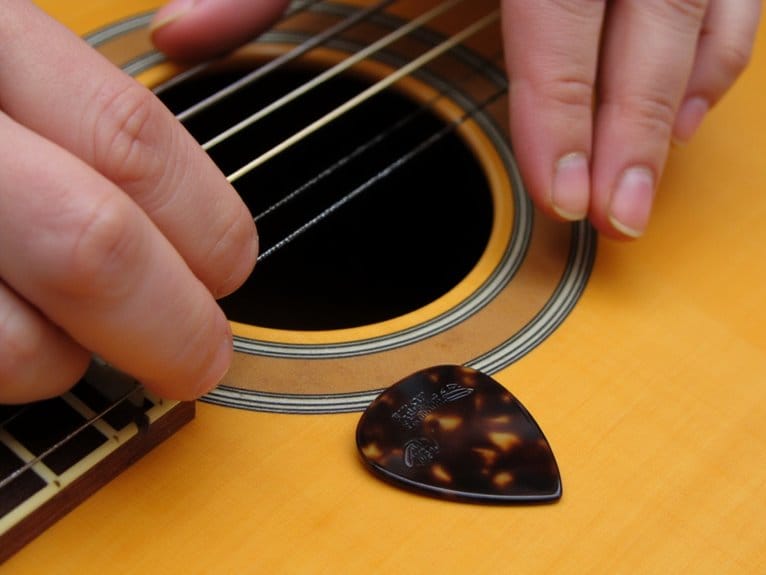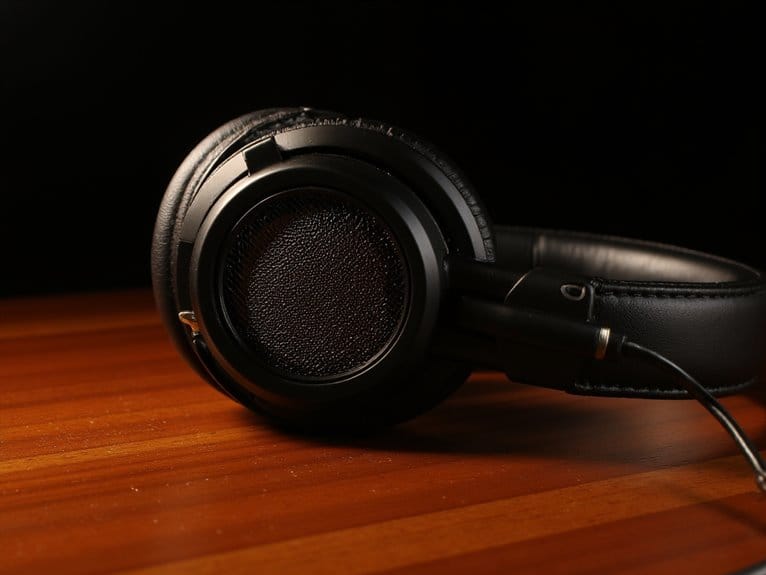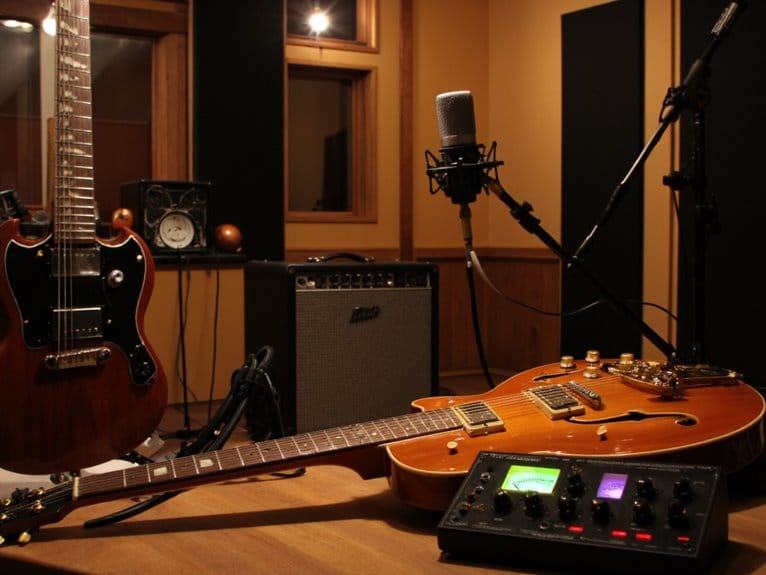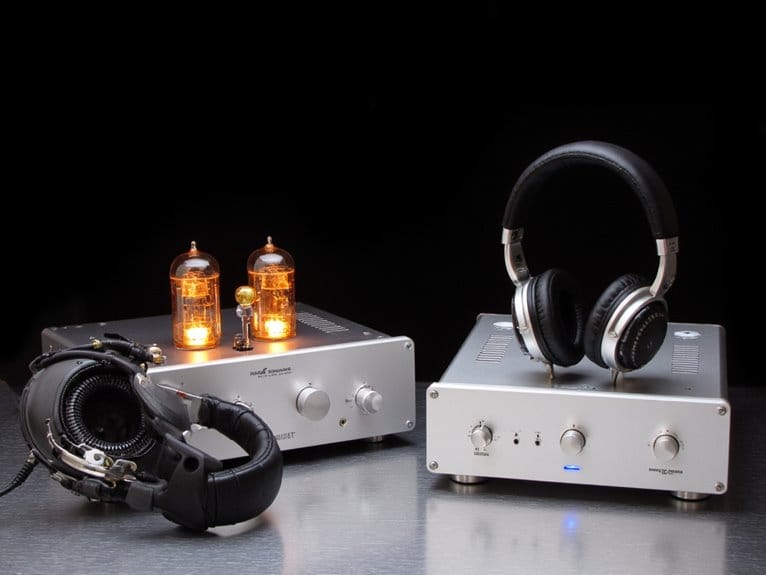Fingerpicking vs. Flatpicking: Developing Both Skills
You’ll want to develop both flatpicking and fingerpicking since each technique serves distinct musical purposes, with flatpicking excelling in rapid single-note runs and rhythmic strumming through consistent plectrum attack, while fingerpicking offers superior polyphonic capabilities and nuanced tones through independent finger control. I’ve found that structured practice sessions using metronomes, technique shift exercises, and hybrid approaches combining pick-and-finger methods greatly expand your versatility across genres from bluegrass to classical, and mastering these fundamentals opens advanced performance strategies.
We are supported by our audience. When you purchase through links on our site, we may earn an affiliate commission, at no extra cost for you. Learn more.
Notable Insights
- Flatpicking uses a plectrum for bright, consistent tones while fingerpicking employs individual fingers for softer, polyphonic sounds.
- Practice both techniques simultaneously with structured drills and metronome exercises to gradually increase speed and precision.
- Flatpicking excels in rock and bluegrass single-note runs while fingerpicking suits classical and flamenco complex arrangements.
- Technique shift exercises enable seamless switching between methods within songs, expanding repertoire and reducing physical strain.
- Hybrid picking combines plectrum attack with finger warmth, allowing simultaneous execution of bass lines, melody, and harmony.
Understanding the Core Differences Between Techniques
When I first picked up a guitar, I’ll admit I didn’t fully grasp how dramatically different flatpicking and fingerpicking techniques could be.
When I started learning guitar, I never imagined how vastly different these two fundamental techniques would prove to be.
But after years of exploring both approaches, the distinctions have become crystal clear regarding mechanics, sound production, and musical possibilities.
The fundamental style comparison reveals that flatpicking employs a single plectrum held between your fingers, producing consistent, bright tones through larger wrist and forearm motions.
In contrast, fingerpicking uses individual fingers to pluck strings independently, creating softer, more nuanced sounds with polyphonic capabilities.
Each approach offers distinct technique advantages: flatpicking excels for rapid single-note runs and rhythmic strumming in rock and bluegrass styles, whereas fingerpicking accommodates complex classical and flamenco arrangements requiring simultaneous melody and bass lines through superior finger independence and coordination.
Building Proficiency in Both Flatpicking and Fingerpicking Methods
Although mastering both flatpicking and fingerpicking might seem intimidating at first, I’ve found that developing proficiency in each technique simultaneously actually accelerates your overall guitar skills more effectively than focusing on just one approach.
Your practice sessions should incorporate structured drills that isolate each method before attempting to combine them, which prevents developing counterproductive habits that’ll plague you later. I recommend dedicating specific time blocks to fingerpicking accuracy exercises and flatpicking alternate-picking patterns, using a metronome to gradually increase your speed and precision. Since nylon strings are gentler on fingers and easier to press down, they can be particularly beneficial when developing fingerpicking techniques during extended practice sessions.
The real magic happens when you start working on technique shift exercises, where you’ll switch between methods within single songs, ultimately expanding your versatility across multiple genres while reducing physical strain from overusing one approach. When practicing these techniques, consider exploring resonator guitars which excel in both flatpicking and fingerpicking applications, particularly for blues and folk styles where technique versatility becomes essential.
Mastering Hybrid Approaches for Enhanced Musical Expression
Once you’ve built solid foundations in both flatpicking and fingerpicking techniques, I’ve discovered that hybrid picking represents the most versatile approach for expanding your musical expression, effectively combining the percussive attack of a pick with the polyphonic warmth that only fingers can deliver.
This method allows you to execute bass lines, melody, and harmony simultaneously, creating layered textures that simulate multiple instruments. The enhanced expression comes from dynamic contrast within single performances, while tonal variety emerges from alternating between pick brightness and finger warmth.
Though coordinating both hands initially feels awkward, dedicated practice develops the independence needed for fluid changes.
Artists like Steve Howe and Guthrie Govan demonstrate how hybrid techniques open up repertoire possibilities across country, rock, and jazz genres.
On a final note
You’ve now got the roadmap to develop both fingerpicking and flatpicking techniques, though I’ll admit mastering either one takes considerable dedication and practice time. Don’t feel pressured to choose sides in this musical debate – many accomplished guitarists seamlessly blend both approaches depending on the song’s requirements. Your journey toward technical versatility will open doors to countless musical styles, from classical arrangements to bluegrass progressions, ultimately expanding your creative expression.







